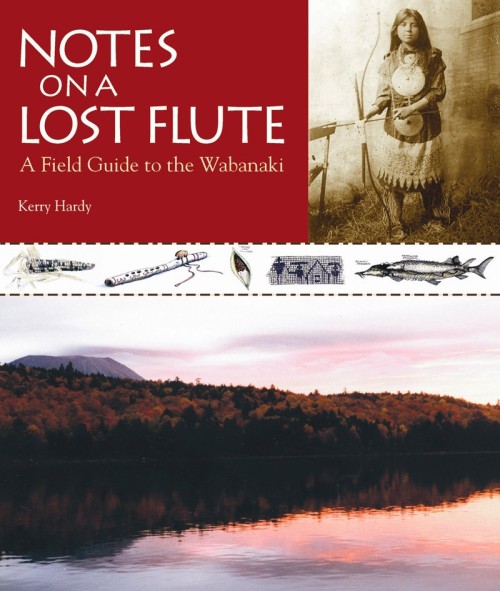by By Kerry Hardy
Down East Books, 2009
N. Scott Momaday writes, in The Man Made of Words, “The storyteller’s place, within the context of his language, must include both geographical and mythic frame of reference. Within that frame of reference is the freedom of infinite possibility.”
In Notes on a Lost Flute, Kerry Hardy’s first book, infinite possibility abounds. A fine storyteller and ardent researcher, his essays incorporate philological scholarship and linguistics that are evidenced in the current language and place names of New England’s – and especially Maine’s – once primary inhabitants, the native Wabanaki tribes. The esoteric and the mundane become, on every gloriously illustrated page, fertile fodder for him. He is eager to share his fascination with language, forestry, gardening, environmental science, and old Native American customs and knowledge that can be relevant to our lives today.
Hardy challenges the reader in enjoyable ways. Instead of footnotes, Hardy enriches the text with sidebars, photos, and drawings that enchant: a subtle urge to readers to flip the pages slowly. The book contains elements of language, cultural history, and vital information, such as how to build a mobile home (a wigwam), the names for the moons of each month, a Hardy-imagined chart showing the Wabanaki food for each month depending on availability, plant medicines, the fur trade, and how to fish for that now-too-rare delicacy, the sturgeon. There are numerous notings on different trees and their uses and on edible plants.
His prose is inventive: “If I had to choose just one place to tell the story of Maine’s human history, I’d take Damariscotta. That very name is enough to send archaeologists into raptures… Damariscotta, along with the rest of mid-coast Maine is the landform equivalent of ribbon candy.”
Where does the title come from? “I wanted something cryptic,” Hardy says. “Something that left an unanswered question.” Hardy includes a sidebar about what many consider the world’s oldest musical instrument. A recent Wall Street Journal article describes the discovery of what is believed to be a 35,000-year-old flute made from a wing bone – highlighting “a prehistoric moment when the mind learned to soar on flights of melody and rhythm.”
Notes on a Lost Flute is filled with Hardy’s irrepressible sense of wonder, with the challenge of life once lived in ways that have brought us to the present moment. “What fun,” he writes, “to wander through time each night, filling notebooks with nuggets of history as easily as one might forage mushrooms while rambling in his own woodlot. In the pages that follow, I will collect, jiggle, sort…share glimpses of a vanished people and their landscape.”


